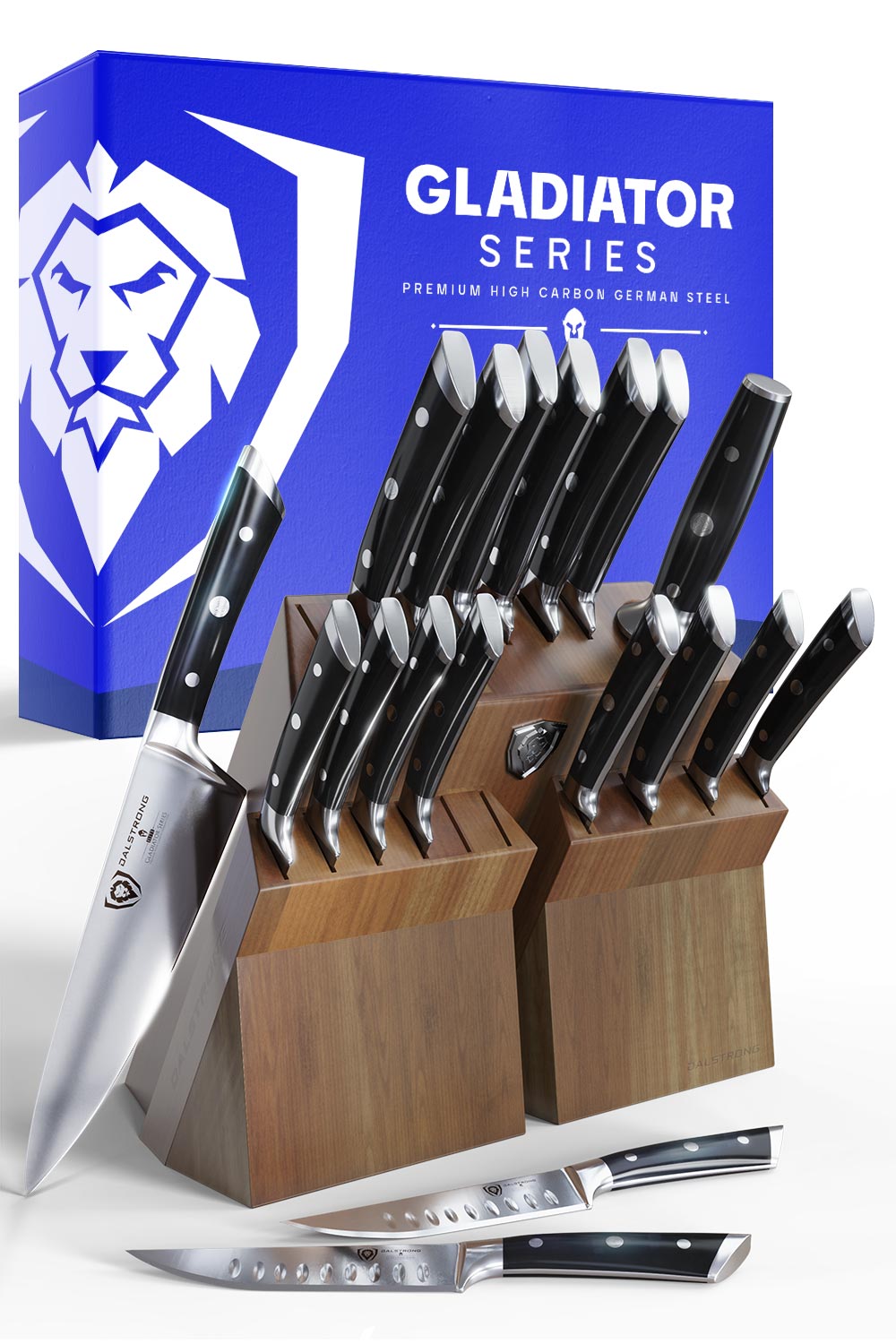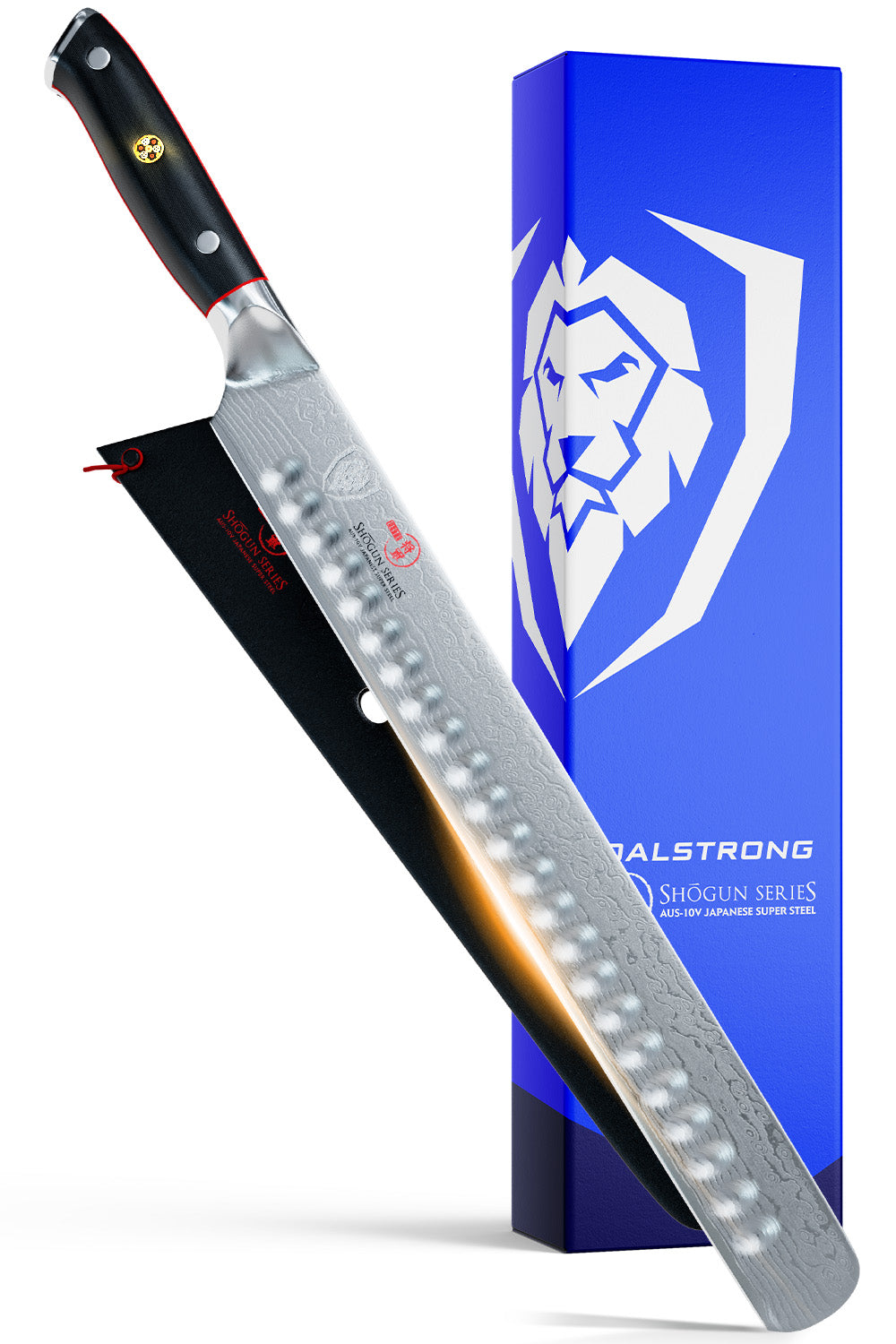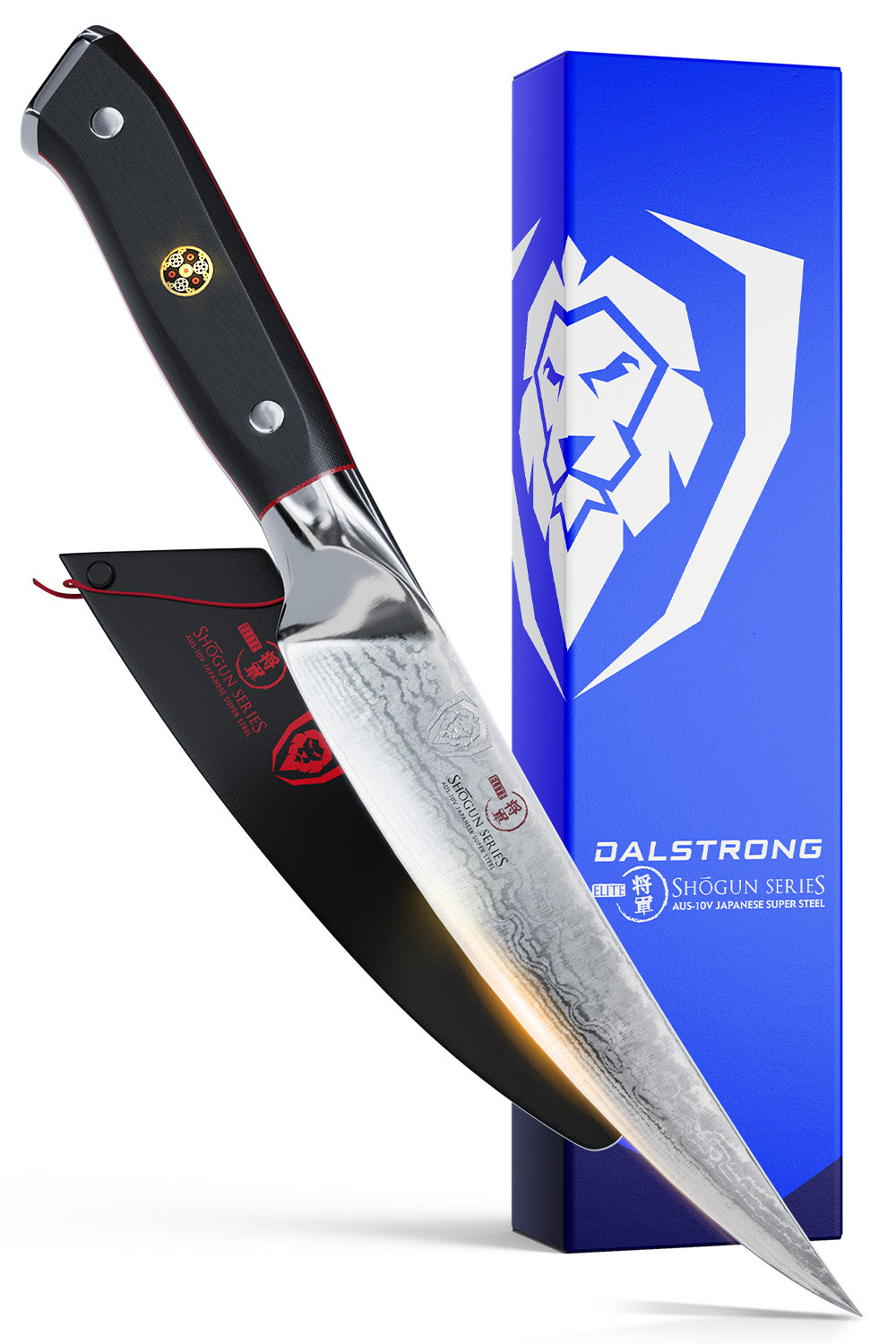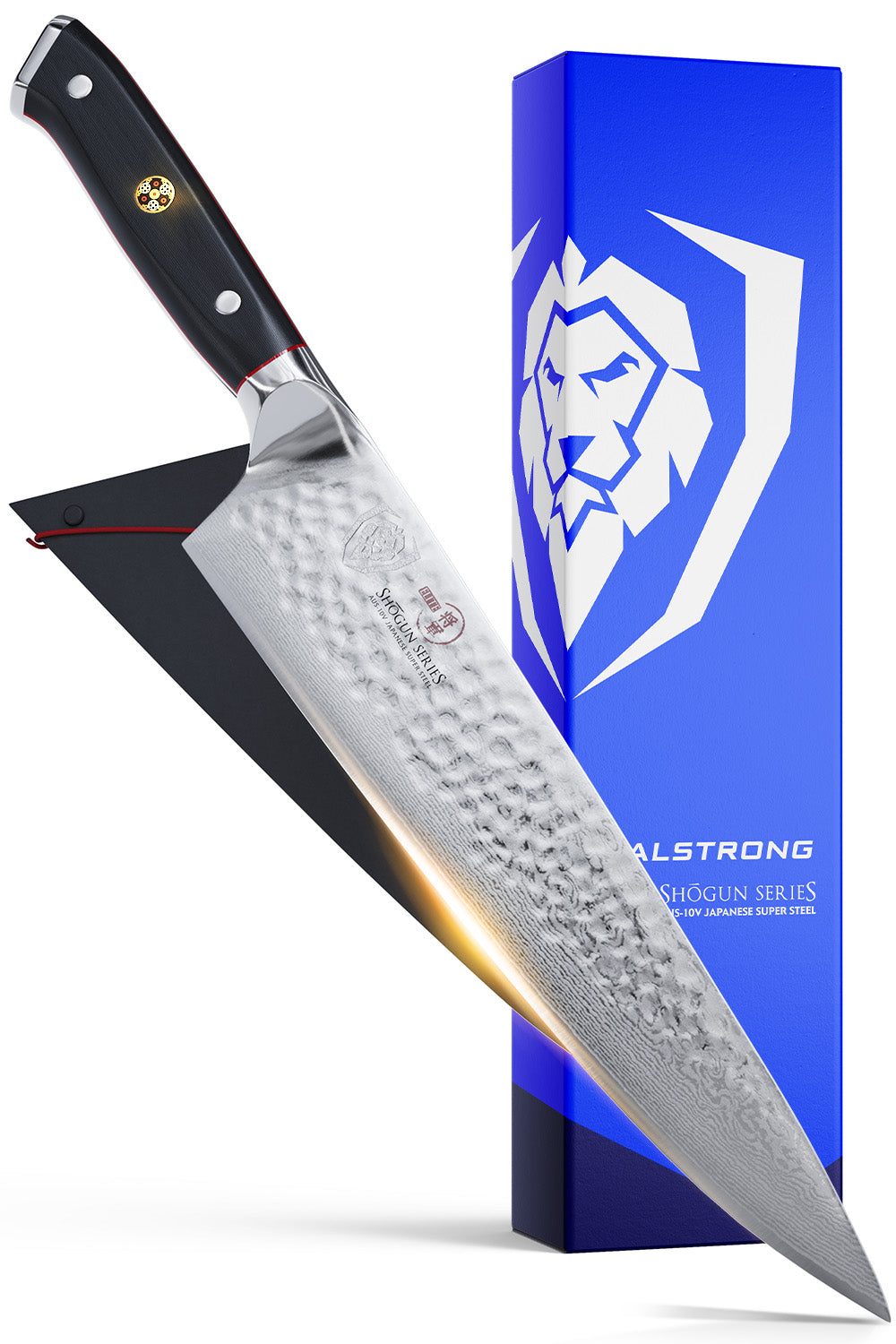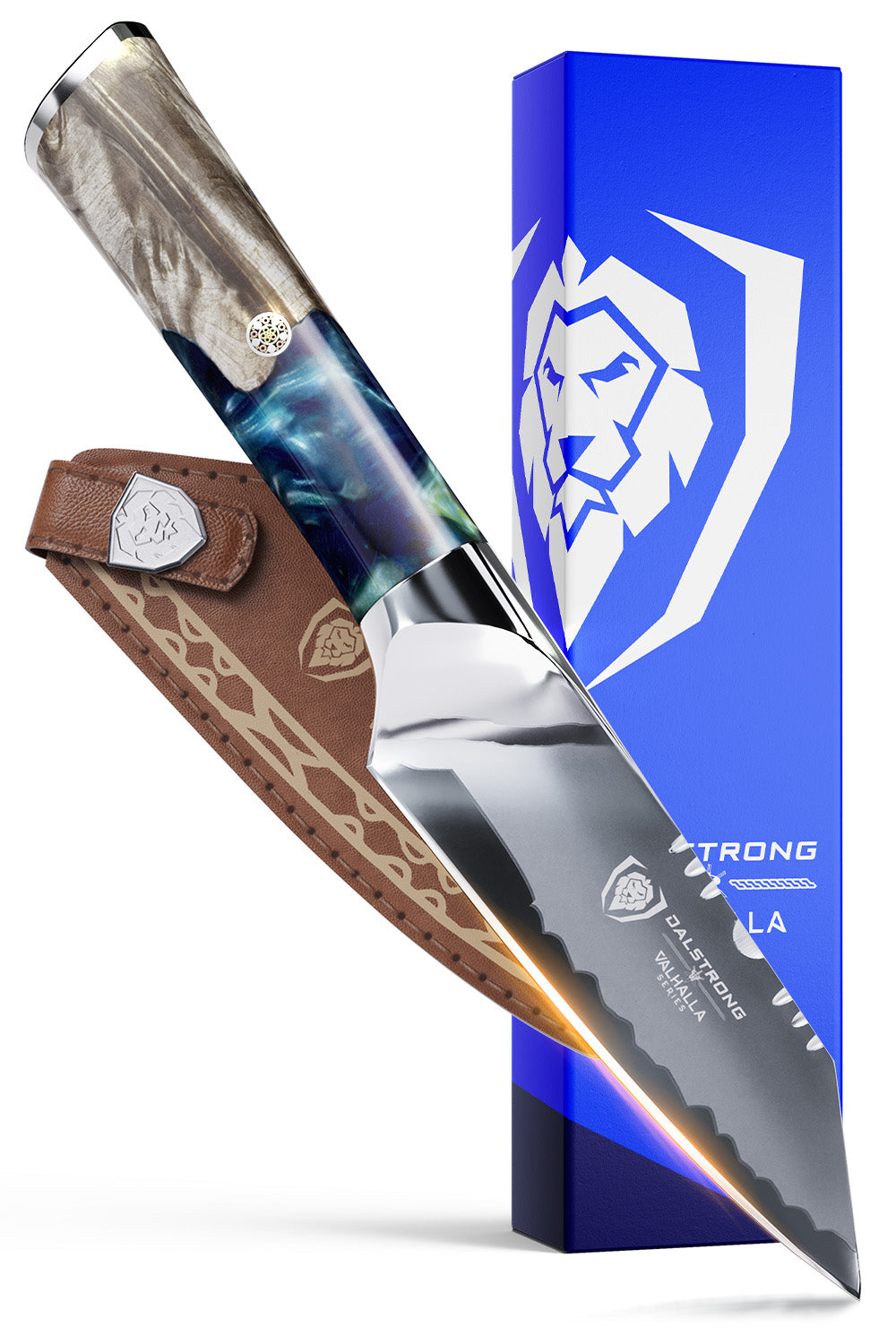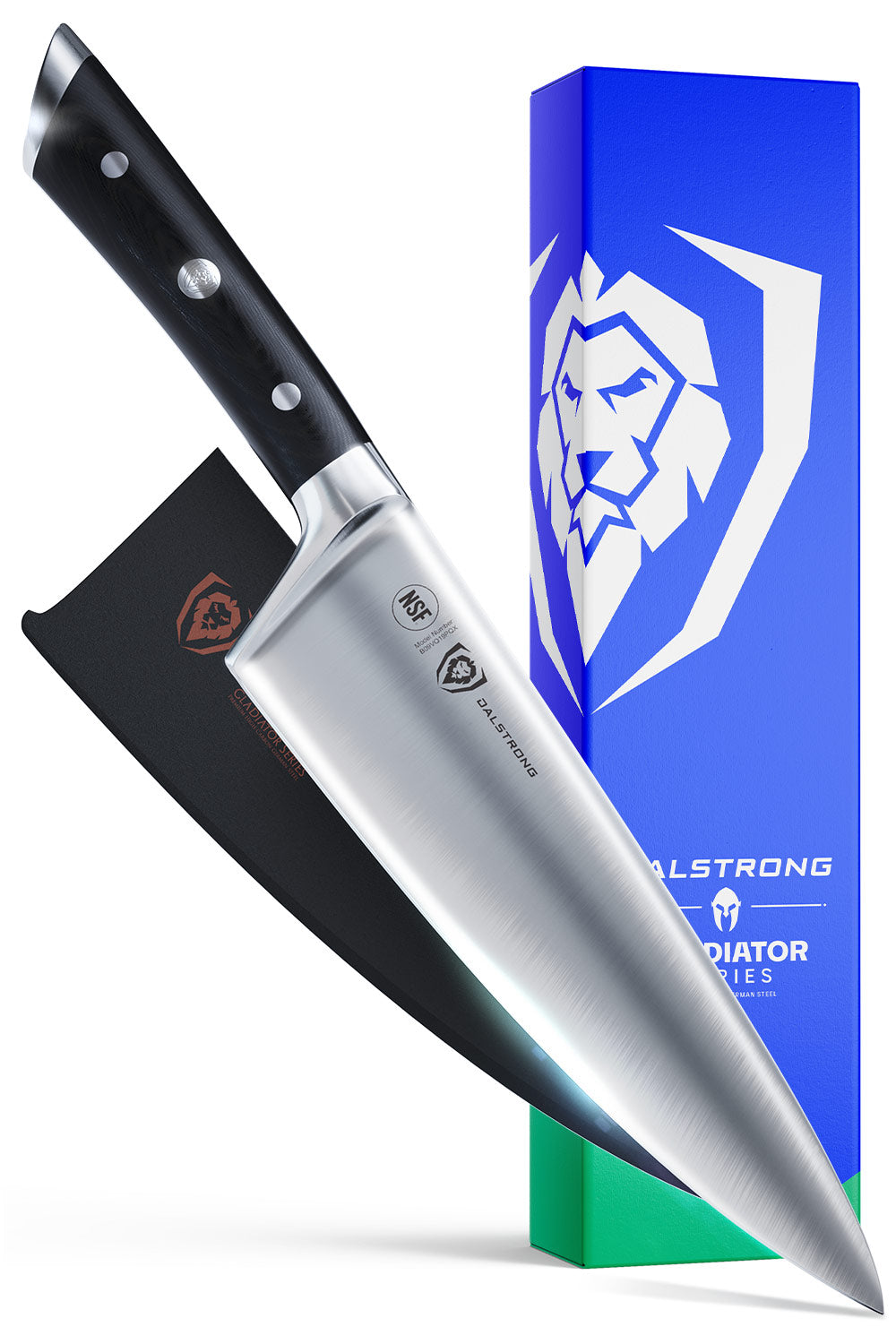 18 Piece Colossal Knife Set with BlockGladiator Series | Knives NSF Certified | Dalstrong
18 Piece Colossal Knife Set with BlockGladiator Series | Knives NSF Certified | Dalstrong
The variety of knives available on the market today can be dazzling – and overwhelming. While most people are familiar with the classic chef’s knife, it can be hard for home chefs to know where to start. If you’re a beginner, consider starting with a set featuring five essential knives and knife blade types, like a chef’s knife, utility knife, paring knife, bread knife, and specialty knife suited to your needs, like a boning knife, oyster knife, or carving knife. From there, you can expand your collection to include more exotic styles.
Before you get started, though, it’s good to know the basics. Here, you’ll find information on a variety of different knife styles so you can decide for yourself which ones best suit your kitchen.
 Chef's Knife 8"Firestorm Alpha Series | Dalstrong
Chef's Knife 8"Firestorm Alpha Series | Dalstrong
1. 10 Most Popular Kitchen Knife Types
Chef’s Knives
Perhaps the most integral part of any knife collection, chef’s knives are versatile knives used for a wide variety of tasks. Relatively large, they are typically around 8” long, though they can vary in length.
In the West, German and French knife blade shapes are among the most popular. French knives are typically slightly thinner and lighter with a straighter blade, while German knives are heavier and feature a blade with a deeper curve.
While French and German style knives have been used in Western kitchens for centuries, Japanese chef’s knives have become increasingly popular worldwide in recent decades.
Japanese chef’s knives are typically lighter and made of harder steel. While hard steel may seem like an advantage, keep in mind that it can chip more easily and can be difficult to sharpen with a knife sharpener. When purchasing a chef’s knife, consider what type of steel will best suit your needs.
Utility Knives
The term “utility knife” is often used to refer to an all-purpose outdoor folding knife. However, when used in a culinary context, the term refers to a mid-length fixed blade knife that falls between paring knives and full-length chef’s knives. Utility knives are sometimes called “sandwich knives,” though they can be used for a wide variety of kitchen tasks. Japanese-style utility knives are called “petty knives,” and serve a similar purpose.
Utility knives are typically 4” to 7” long, and are sometimes serrated. They’re particularly useful for slicing foods that are too small for a chef’s knife and too large for a paring knife, and you’ll likely find yourself reaching for one often.
Paring Knives
Paring knives are small knives intended for delicate work such as peeling, pitting, cutting fruit, and creating garnishes. You can even use a paring knife as a cheese knife for harder cheeses such as parmesan. They have short blades, typically 2” to 4” long, but despite their small size, paring knives are one of the most essential knives and are considered a necessity in any kitchen.
While most paring knives look like miniature chef’s knives, bird’s beak paring knives feature a blade that curves inwards. These knives are intended for peeling fruit and other precise tasks. However, you might find them less versatile than traditional paring knives.
Bread Knives
Bread knives are long, serrated knives designed to cut bread and baked goods into smooth slices with minimal crumbs. Though serrated knives have been around for centuries, the modern iteration of bread knives wasn’t invented until 1921, when Joseph E. Burns introduced a design that featured small cutting edges in between the serrations.
While bread knives are most commonly used for, well, bread, they have a wide variety of other uses, too. They are ideal for slicing foods that are tough on the outside and soft on the inside, like melons, fruits with thick skins, and tough sausages.
Bread knives rarely need to be sharpened. Repeatedly hitting the hard surface of a cutting board will significantly dull the blade of a knife over time – one reason why wooden cutting boards are preferable to glass or ceramic. Because the cutting edge of a bread knife is recessed, it doesn’t hit the surface of the cutting board, which helps keep a sharp edge. However, you may need to sharpen your serrated knife at some point, and you should hone it regularly.
Nakiri Knives
While Japanese santoku knives are known as all-purpose kitchen knives, nakiri knives are specifically designed for slicing fruits and vegetables. Like a cleaver, nakiri knives are characterized by a wide, rectangular blade with a straight cutting edge. However, the blade is typically smaller and narrower than that of a cleaver, and the knife is usually lighter weight.
Unlike Western chef’s knives, which have a curved blade and are typically used with a rocking motion, nakiri knives are intended to be used with a straight, vertical chopping motion. This is useful for creating clean cuts and dicing vegetables into small pieces.
Fillet Knives
Fillet knives are thin knives used for filleting fish. While they’re popular in kitchens, they’re also convenient on fishing trips. They often have flexible blades that can easily maneuver around delicate bones.
If you’re shopping for a knife that you plan to take on fishing trips, look for a corrosion-resistant blade and a comfortable handle. Since you’ll likely be using the knife in a wet, messy environment, you’ll want to make sure that you can grip the handle securely and that the blade won’t be damaged by saltwater.
Boning Knives
Boning knives are similar to fillet knives in both shape and purpose. Both boning and fillet knives are designed to remove bones from meat, but fillet knives are specifically intended for cutting the delicate flesh of fish. While boning knives tend to have a relatively thin blade, fillet knives are thinner and tend to be more flexible.
Boning knives are essential for any chef who regularly prepares meat. The design allows for precision when cutting bones, skin, and sinew out of a side of beef or pork, while the comparably sturdy blade helps slice through tough flesh. However, if you’re looking for something that will chop large pieces of meat into smaller chunks, consider a butcher’s knife or cleaver.
Butcher’s Knives
Often confused with cleavers, butcher knives typically feature long, sturdy, slightly curved blades that often slope to a point. Like cleavers, they are intended for slicing large pieces of meat. However, butcher’s knives are more versatile in that they can be used to skin and bone meat as well as chopping it into pieces. Traditionally, this style was sometimes used as a hunting knife.
Due to their shape, butcher’s knives can be more agile and efficient than cleavers. You’ll likely have trouble making precision cuts with a cleaver. However, if you need a truly heavy duty meat knife, a cleaver will be your best bet.
Cleavers
Large, rectangular, and shaped a bit like a hatchet, cleavers are kitchen powerhouses that can chop through the toughest meat – and even bone. Western cleavers often have a hole in the blade. This hole can be used to hang the cleaver, since the large size of the knife means that it won’t fit in a traditional knife block or magnetic knife holder. Some chefs also use the hole for leverage when gripping the blade.
While Western cleavers are often made of thick, heavy steel to avoid chips when cutting through meat, Chinese cleavers are typically lighter weight. This means that they may not be suited for the heavy-duty work of a Western cleaver. However, they are still remarkably versatile knives. Though sometimes called “vegetable cleavers,” a skilled Chinese chef can use a Chinese cleaver for just about anything – even filleting fish.
Steak Knives
Intended for use at a dining table rather than a kitchen, steak knives are small, sharp knives meant for cutting steak and tough meats. Keep in mind that steak knives will need frequent sharpening, since they’re sharper than regular table knives and go dull easily from hitting against the hard surface of a plate.
Steak knives come in two types – serrated and with a straight edge. Both styles are widely popular and come with their own advantages. While a serrated edge makes it easier to cut through meat, a straight edge will provide you with a cleaner cut.
2. Best Dalstrong Kitchen Knives
Best Chef’s Knife
The Dalstrong Delta Wolf Series Chef’s Knife 10”
One of Dalstrong’s best selling chef’s knives, the Delta Wolf Series Chef’s Knife 10” brings military precision to your kitchen. Created to honor Special Operations soldiers, the camouflage G10 Garolite handle and rugged high-carbon precision-forged steel blade help bring a tactical edge to the classic chef’s knife design.
Pros
- Proceeds from this knife support the Wounded Warrior Project and Wounded Warriors Canada.
- The sleek black blade is coated in non-reflective titanium nitride, which helps strengthen the blade and prevent corrosion.
Cons
- The tough, military-inspired look of this knife isn’t for everyone. For the chef who favors a classic look, consider the Gladiator Series Chef’s Knife 10” instead.
Best Utility Knife
The Dalstrong Crusader Series 6” Utility Knife
Not only is this option durable, affordable, and sleek, but it’s also one of the most versatile knives in your kitchen. Walking the line between a full-size chef’s knife and a paring knife, you’ll find that this knife is easy to maneuver due to its size, while still being large enough for cutting through most fruits and vegetables. The blade, which is made of German ThyssenKrupp Steel, smoothly transitions into a high-chromium stainless steel handle.
Pros
- The Crusader Series offers premium craftsmanship at an affordable price point.
- The seamless design of this knife means that it’s a particularly hygienic option – easy to clean and stain-resistant.
Cons
- Some chefs prefer serrated edge utility knives – especially for making sandwiches. The Gladiator Series 6” Serrated Utility Knife is a good alternative.
- Thanks to the softer nature of German steel, you’ll have to sharpen this knife more often than some of the other options on this list.
Best Paring Knife
The Dalstrong Gladiator Series 3.5” Paring Knife
With a small, narrow blade perfect for precision work, the Dalstrong Gladiator Series 3.5” Paring Knife will doubtlessly become an essential part of your knife collection. Small but mighty with a precision-forged full-tang stainless steel blade, this knife is as durable as it is elegant. Not only will it last a lifetime, but the ergonomic handle made from G10 Garolite and second bolster for added balance ensures that it’s a pleasure to use.
Pros
- This is one of Dalstrong’s most affordable options – perfect for someone cautiously entering the world of professional kitchen knives.
- At 56+ Rockwell hardness, this knife’s durable stainless steel blade is hard enough to keep its edge but not so hard that it’s brittle.
Cons
- If you’re feeling adventurous, try a bird’s beak paring knife. While not as versatile as a classic paring knife, these curved knives are perfect for peeling fruits or carving garnishes.
- This knife is a great budget option – but if you’re looking for something a little more deluxe, consider the Firestorm Alpha 3.75” Paring Knife or the Shogun Series 3.5” Paring Knife.
Best Bread Knife
The Dalstrong Shogun Series 10.25” Serrated Bread Knife
Whether in a home kitchen or professional bakery, this elegant knife can slice through even the crispiest crusts without leaving crumbs behind. This knife isn’t just for bread, though – its ultra-premium Japanese AUS-10V serrated steel blade can cut through meats, melons, and even delicate foods. Who knew that a bread knife could make a great tomato knife, too?
Pros
- Sharpening bread knives can be tricky, but thanks to this knife’s ultra-hard 62+ Rockwell blade, you’ll rarely have to worry.
- The long blade cuts through bread with long, smooth strokes – making for smooth slices with minimal crumbs.
Cons
- 62+ Rockwell hardness can be brittle. While that shouldn’t be an issue for bread, opt for a softer blade if you routinely use your knife for tougher foods.
- At 10.25,” some people may find the blade unwieldy.
Best Nakiri Knife
The Dalstrong Phantom Series Nakiri Vegetable Knife
An homage to the traditional Japanese knife, the Dalstrong Phantom Series Nakiri Vegetable knife celebrates the past while embracing modern technology. This is a forged knife, crafted from premium AUS-8 Japanese stainless steel at 58 Rockwell hardness and hand polished to a satin finish. The unique, slightly irregular shape of the pakkawood handle is designed to rest comfortably in the palm of your hand.
Pros
- At 58 Rockwell hardness, this knife is resistant to chips but hard enough to retain an edge.
- The flat blade of a nakiri knife makes it particularly useful for dicing and mincing.
Cons
- Nakiri knives are specialized knives intended for slicing vegetables – if you’re interested in a more versatile Japanese kitchen knife, consider a santoku knife, which is intended for chopping meat and fish as well.
- Chefs used to Western chef’s knives may find the shape of the nakiri knife difficult to get used to.
Best Butcher’s Knife
The Dalstrong Shadow Black Series 10” Bull Nose Butcher’s Knife
The sleek, angular design of the Shadow Black Series Butcher’s Knife conveys power and strength – traits that this 10” high carbon steel blade embody. Coated with matte black titanium nitride to enhance the knife’s non-stick properties and prevent corrosion, the 58 Rockwell blade can slice through even the most daunting cuts of meat.
Pros
- 58 Rockwell hardness means the steel is soft enough to prevent chips, but tough enough to retain an edge.
- The unique, modern design makes this knife stand out.
Cons
- Some people may prefer a more traditional design, like the Shogun Series 8” Butcher Knife.
- If you want a butcher’s knife for large cuts of meat, consider a 14” butcher’s knife instead.
Best Fillet Knife
The Dalstrong Omega Series 6” Curved Boning and Fillet Knife
Thin and flexible, fillet knives make the tricky task of cleaning and boning fish easy. This knife may look fancy, but the military-grade G10 handle and corrosion-resistant cladding mean that it’s capable of both slicing through delicate fish meat and surviving rough-and-tumble fishing trips.
Pros
- Precise cryogenic tempering enhances the steel’s structure for strength, hardness, and flexibility.
- Since filleting fish is a wet and messy process, the ergonomic handle ensures a secure grip.
Cons
- Want a straightforward design? Consider the Gladiator Series 7” Flexible Fillet Knife.
- While the 6” blade is suitable for cutting most kinds of fish, larger fish, like tuna and halibut, necessitate a longer knife.
Best Boning Knife
The Dalstrong Quantum 1 Series 6” Boning Knife
Expertly designed for maximum performance, the Dalstrong Quantum 1 Series 6” Boning Knife can deftly slice through sides of meat to slice away unwanted bones, fat, and senew. The blade is precision forged from BD1N-VX stainless steel at 63+ Rockwell hardness, ensuring that this knife will retain its shockingly sharp cutting edge no matter what you put it through.
Pros
- The tapered design is both sturdy and flexible – the way a boning knife should be.
- The blade features Dalstrong’s unique “nova prime” pattern, which helps reduce drag while adding a touch of aesthetic flare.
Cons
- Some people may prefer a softer blade, which helps prevent chips.
- If you want a more versatile knife, consider a 2-in-1 boning and fillet knife.
Best Cleaver Knife
The Dalstrong Gladiator Series 9” Meat Cleaver
With a thick, 9” stainless steel blade, this heavy-duty meat cleaver is an imposing sight. Perfect for slicing through even the toughest meats, this sturdy, precision-forged blade is the perfect addition to the collection of any chef who regularly works with large slabs of meat. The ergonomic G10 Garolite handle makes this behemoth easy to use, and the 60 Rockwell blade will hold its edge.
Pros
- Cleavers can be difficult to store, so this knife includes an acacia wood stand as well as holes along the edge to give you the option of hanging it from the wall.
- At 6mm thick, the sturdy blade of this knife is resistant to chips.
Cons
- Want to try an Asian-style cleaver instead? Consider the Shogun Series 7” Cleaver, inspired by Chinese and Japanese designs.
- Some people may find large, heavy cleavers unwieldy.
Best Steak Knife
The Dalstrong Shogun Series 4 Piece Steak Knife Set
Unlike most other knives on this list, steak knives aren’t hidden away in the kitchen. While your friends and family already know that you’re a great cook, premium steak knives, like Dalstrong’s Shogun Series 4 Piece knife set, help take their dining experience to the next level. Forged from Japanese AUS-10V steel, these striking knives are engineered for perfect balance and ergonomic comfort, ensuring comfort and ease of use.
Pros
- Eye-catching yet classic, the design is a sophisticated option for your dinner table.
- Steak knives need to be sharpened often, but the extra-hard 62+ Rockwell stainless steel that these knives are forged from will help hold a sharp edge.
Cons
- This set is one of Dalstrong’s priciest options. If you’d prefer an economical option, consider the Gladiator Series 8 Piece Steak Knife Set.
- Since steak knives are commonly used at dinner parties, they’re a great way to show off more unique and unconventional designs, like Dalstrong’s Shadow Black Series.
3. Frequently Asked Questions
What are the 5 most common types of knives?
While the popularity of certain knife styles varies by country and culture, the knives most commonly found in Western kitchens include chef’s knives, bread knives, paring knives, utility knives, and carving knives. In recent years, Japanese santoku knives and nakiri knives have been gaining popularity with Western chefs, too.
How many types of knives are there?
While you’re probably already familiar with classic Western kitchen knives, like the chef knife and paring knife, different cultures around the world have developed a near-endless variety of knife styles suited to their particular needs and cuisines. Plus, there are a plethora of knives for other uses – from hunting knives, pocket knives, and the formidable butterfly knife.
What is a bread knife called?
In professional kitchens, the serrated knife used to cut bread is called just that – a bread knife.
What is a meat knife called?































































